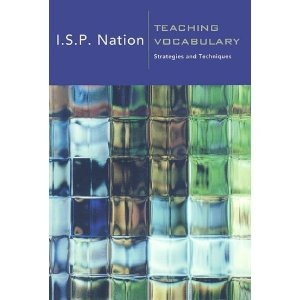I.S.P. Nation.Teaching Vocabulary: Strategies and Techniques
reviewed by Alan Maley, UK

I.S.P. Nation. Teaching Vocabulary: Strategies and Techniques.
2008.
Heinle Cengage Learning.
The revolution in language research brought about by the development of computer-generated corpora has touched many areas of language learning and teaching. Not least among them is vocabulary, our understanding of which has been considerably enhanced. Nation’s book is welcome in that it synthesizes much of this information, and organises it in such a way as to make it teachable. (The present book is in fact, a condensed version of Nation 2001: which at 400 plus pages is beyond most teachers’ means.)
In Chapter 1, The Big Picture, Nation begins by offering a 4-strand strategy for teaching vocabulary, each of which is to be given equal weight. The components are: Meaning-focussed input (through stories, reading, listening to lectures etc.); Meaning-focussed output (through role play, problem-solving, writing activities etc.); Language-focussed learning (through the deliberate study of new words using a set of strategies such as word cards, dictionary work etc.) and Fluency development (through speed reading, extensive reading of familiar material, etc.) in the second part of the chapter, he deals with high frequency words, academic and technical vocabulary.
Chapters 2 and 3 deal with vocabulary and listening and speaking respectively. In each chapter there are activities for each of the 4 strands mentioned in Chapter 1. The activities themselves are well-tried and in no way new, but they are clearly described and exemplified with helpful comments and suggestions to the teacher.
These are followed by a chapter on Intensive Reading, which is clearly related to the deliberate study of words. It consists mainly of helpful suggested strategies for deriving the maximum benefit from the close study of a text.
In Chapter 5, he turns his attention to Extensive Reading, which is full of valuable information and suggestions for implementing extensive reading activities These cover the categories of meaning-focussed input and fluency development.
Chapter 6 deals with Vocabulary and Writing, with a focus on teaching vocabulary to be used in writing. There are again a number of suggested activities, such as semantic mapping, most of which will be familiar.
Chapter 7 is entirely devoted to The Deliberate Teaching and Learning of Vocabulary, which Nation clearly feels is all too often neglected in the current ‘communicative’ paradigm. After considering what is involved in ‘knowing a word’, he suggests a list of simple activities which require little or no preparation, followed by some prepared vocabulary exercises. Quite a lot of emphasis is given to word card strategies, and he emphasises the need to return repeatedly to words which have been newly learnt. There is also a helpful section on dealing with multi-word units.
Chapter 8 deals with teaching specialized vocabulary and will chiefly be of interest to teachers of EAP and ESP, though teaching academic vocabulary is likely to be part of most teachers’ repertoire..
In Chapter 9 the focus is on testing vocabulary: how to gauge learners’ levels, how to construct vocabulary tests, how to use tests to monitor progress, to assign students to levels, and assess final performance. And how to evaluate tests themselves.
The Appendices are extremely useful, comprising the first 1000 words of the General Service List, The Academic Word List,, The Vocabulary Levels Test, A Vocabulary Size Test, The Productive Vocabulary Levels test and a survival Language Learning Syllabus for Foreign Travel.
One minor criticism is the omission of several important contributors (Nattinger and de Carrico, Hoey, and others) to the field from his bibliography.
The main virtue of this book is its clarity and commonsense approach. Nation makes it clear that our main teaching focus has to be on frequent vocabulary: there is insufficient time to waste it on words rarely encountered. Such infrequent vocabulary can be tackled by providing students with the tools for dealing with it on their own.. He shows that learning vocabulary is not all bells and whistles but involves hard work, with a strategic balance between his four strands (see Chapter 1.). This is not a wildly exciting book but it is an invaluable guide to the teaching of vocabulary, couched in clear, no-nonsense language…
Reference.
I.S.P. Nation (2001) Learning Vocabulary in Another Language, Cambridge University Press

Please check the Methodology and Language for Secondary Teachers course at Pilgrims website.


|